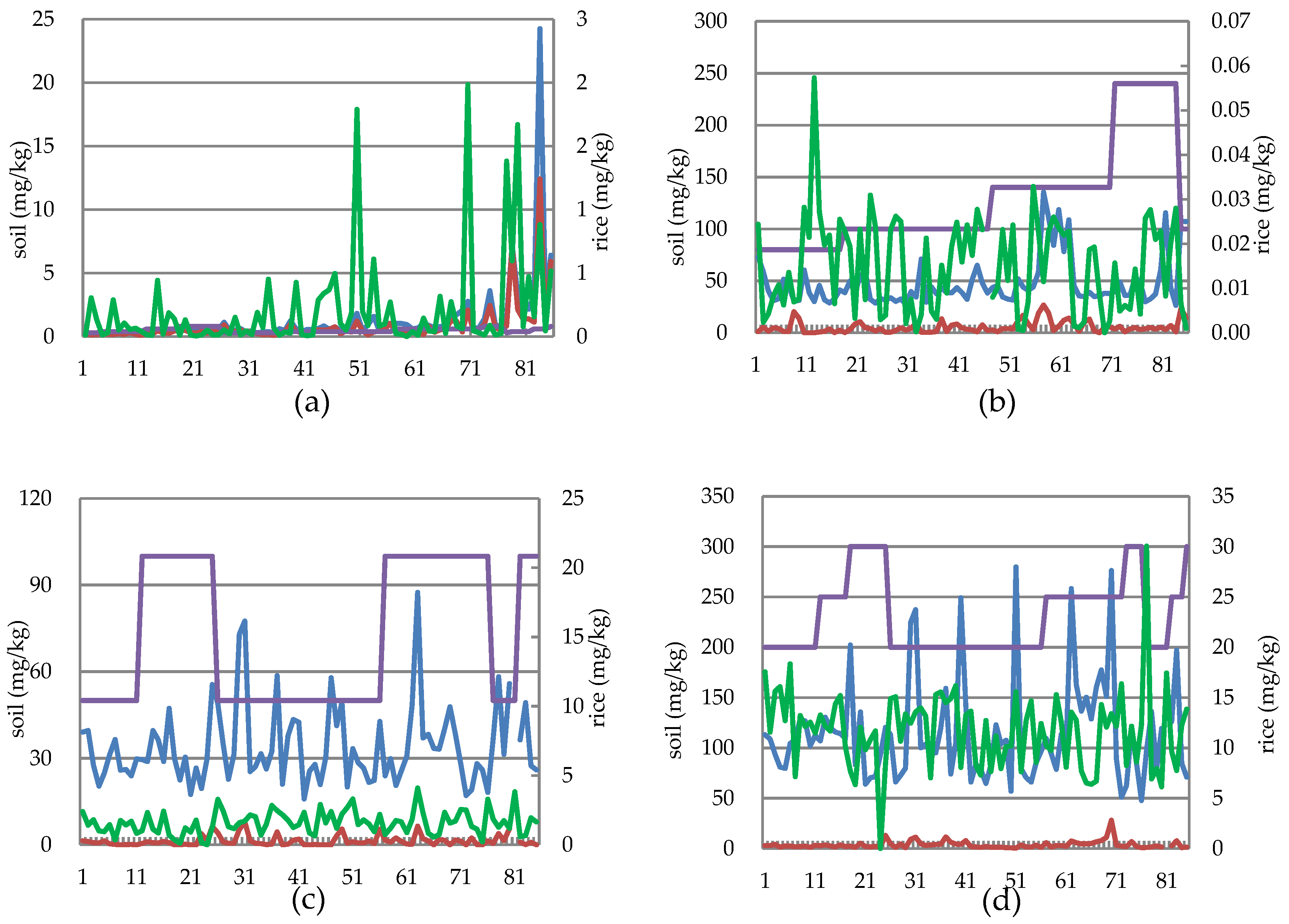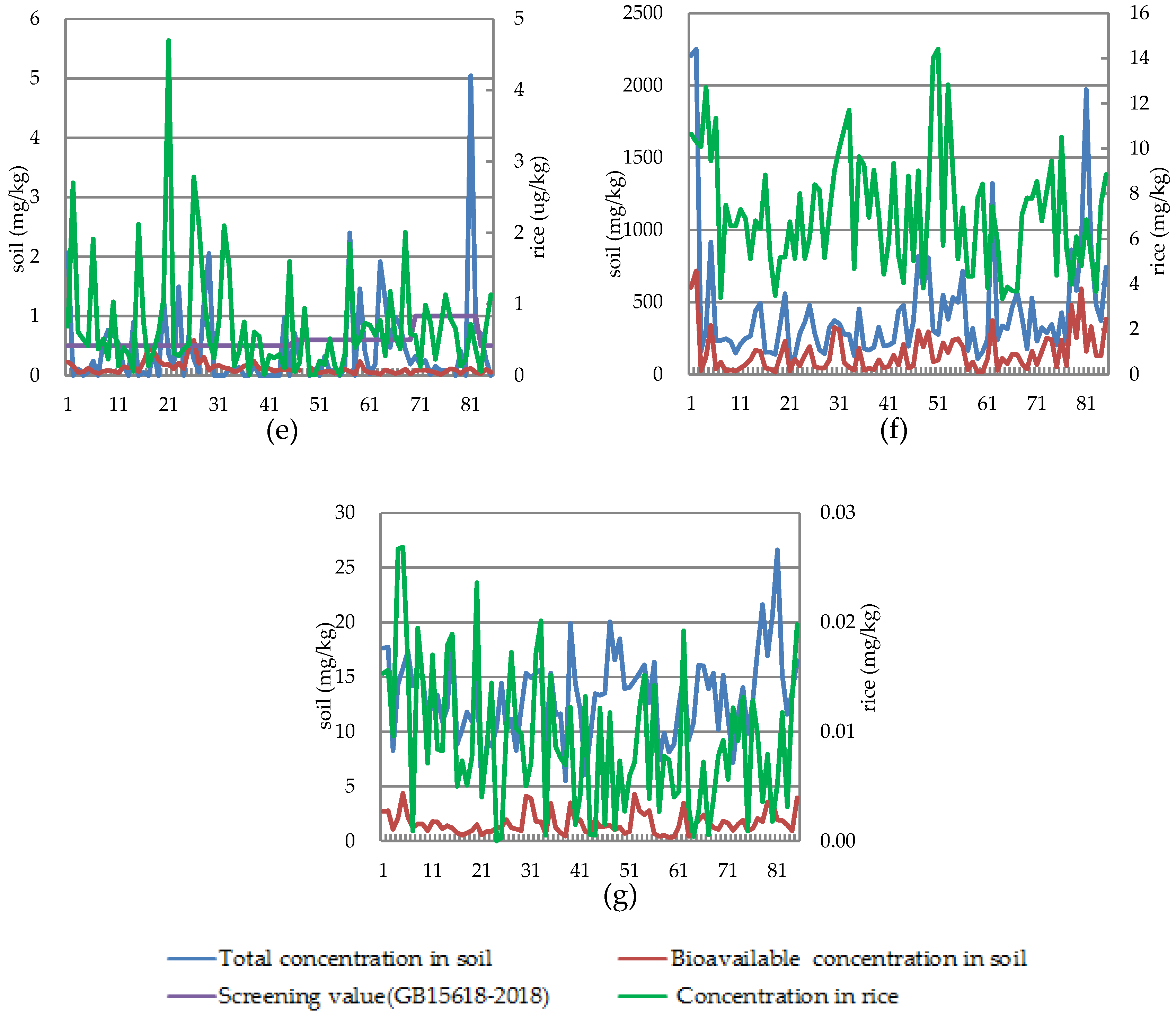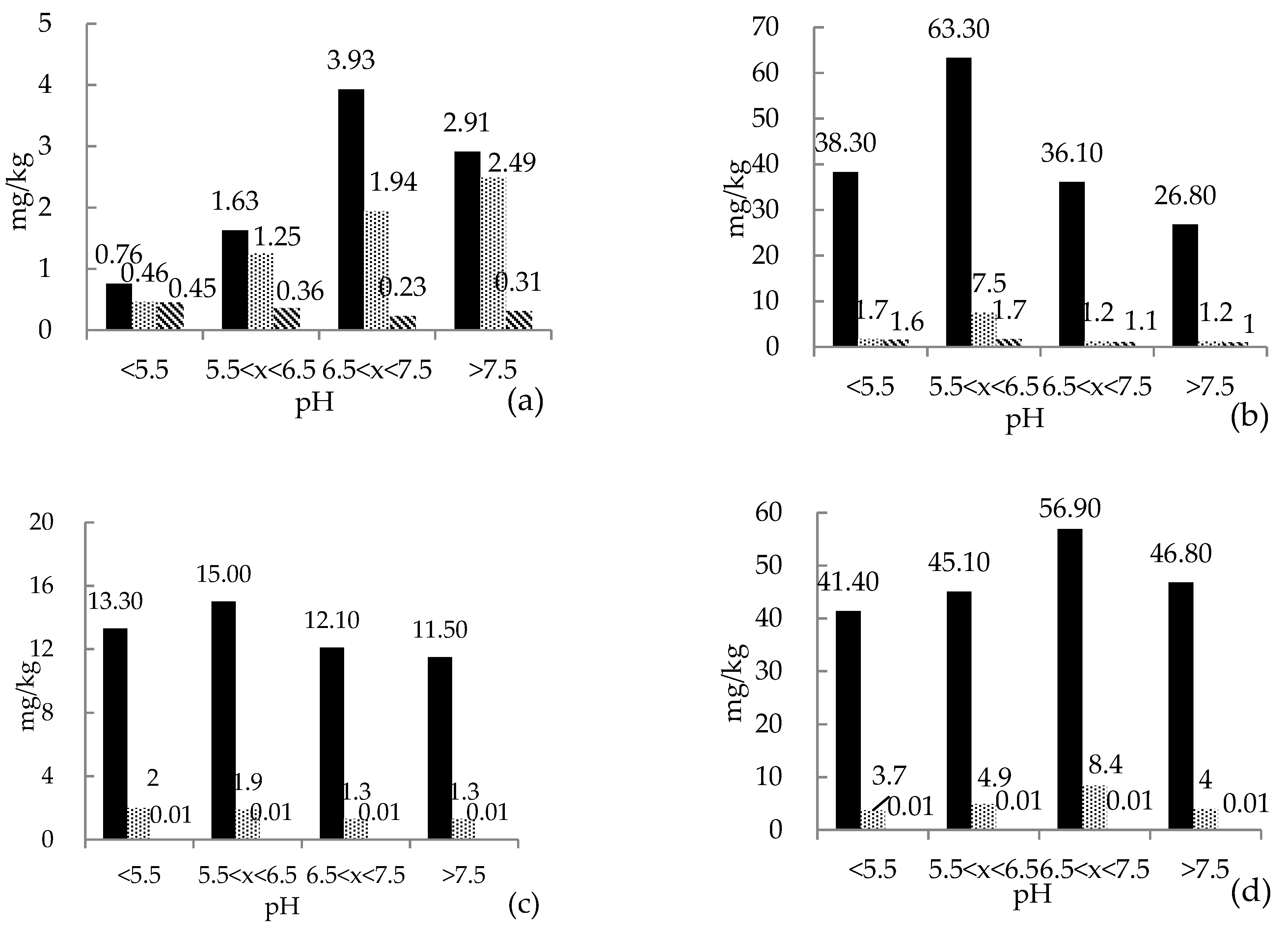Assessing the Risk of Total and Available Potentially Toxic Elements in Agricultural Soil in Typical Mining Areas in Xiangjiang River Basin, Hunan Province
Abstract
:1. Introduction
2. Materials and Methods
2.1. Sampling Sites
2.1.1. Soil Sampling and Preparation
2.1.2. Rice Sampling
2.2. Sample Analyses
2.2.1. Analyses of Total PTEs in Soil
2.2.2. Analyses of Bioavailable PTEs in Soil
2.2.3. Analyses of PTEs Concentrations in Rice
2.2.4. Analyses of Soil pH
2.3. Data Analyses
3. Results
3.1. PTE Concentrations in Soil (Total and Bioavailable) and in Rice Grain
3.2. Correlations between Total and Bioavailable Concentrations in Soil vs. Rice
3.3. Soil pH
3.4. PTEs Concentrations in Rice
4. Discussion
4.1. PTEs Concentrations in Soil and Rice
4.2. Accumulation of PTEs in Polished Rice Grain
4.3. PTEs Concentrations in Soil (Total and Bioavailable) and in Rice Grain under Different pH Conditions
4.4. Risk Assessment of PTEs Exposure through Rice Consumption
5. Conclusions
Author Contributions
Funding
Acknowledgments
Conflicts of Interest
References
- Peng, Z. Strengthen the prevention mines of Shaoguan City, China. Soil Sediment Contam. 2016, 24, 76–89. [Google Scholar]
- Zhou, M.; Liao, B.; Shu, W.S.; Yang, B.; Lan, C.Y. Pollution assessment and potential sources of heavy metals in agricultural soils around four pb/zn mines of shaoguan city, China. Soil Sediment Contam. 2015, 24, 76–89. [Google Scholar] [CrossRef]
- Abdelhafez, A.; Li, J. Environmental monitoring of heavy metal status and human health risk assessment in the agricultural soils of the Jinxi River area, China. Environmental monitoring of heavy metal status and human health risk assessment in the agricultural soils of the Jinxi River area, China. Hum. Ecol. Risk Assess. An. Int. J. 2015, 21, 952–971. [Google Scholar]
- Chen, X.L.; Zhang, W.K.; Li, W.; Li, Z.Z. Brief summarization of study on heavy-metal pollution of soil in China. Yunnan Geogr. Environ. Res. 2009, 21, 8–13. [Google Scholar]
- Lu, Y.W.; Huang, L.B.; Zhang, G.L.; Zhao, Y.G. Assessment of bioaccessibility and exposure risk of arsenic and lead in urban soils of Guangzhou City, China. Environ. Geochem. Health 2011, 33, 93–102. [Google Scholar] [CrossRef] [PubMed]
- Fan, S.X.; Gan, Z.T.; Li, M.J.; Zhang, Z.Q.; Zhou, Q. Progress of Assessment Methods of Heavy Metal Pollution in Soil. Chin. Agric. Sci. Bull. 2010, 26, 310–315. [Google Scholar]
- Ao, M.; Chai, G.Q.; Fan, C.W.; Liu, G.H.; Qin, S.; Wang, P. Evaluation of potential pollution risk and source analysis of heavy metals in paddy soil and rice. Trans. Chin. Soc. Agric. Eng. 2019, 35, 198–205. [Google Scholar]
- Kong, Z.Y.; Teng, Y.G.; Wang, J.S.; Song, L.T.; Zhang, L. Pollution risk assessment of heavy metals in soil based on geochemical baseline. Earth Environ. 2013, 41, 547–552. [Google Scholar]
- Li, G.; Chen, T.L.; Wang, Y.H.; Wang, S.C.; Li, B.; Cui, J.H.; Zhang, H. Progresses on risk assessment methods of bioavailability of heavy metal in soils. J. Food Saf. Qual. 2014, 5, 3592–3597. [Google Scholar]
- Liu, J.; Teng, T.Y.; Cui, Y.F.; Wang, J.S. Review in ecological risk assessment methods for heavy metal polluted soils. Adm. Tech. Environ. Monit. 2007, 19, 6–11. [Google Scholar]
- Environmental Protection Administration of China. Soil Environmental Quality Risk Control Standard for Soil Contamination of Agricultural Land; GB15618-2018; Environmental Protection Administration of China: Beijing, China, 2018.
- Sun, X.Y. Phytoavailability of Heavy Metals in Soils from Lead-Zinc Mining Area. Ph.D. Thesis, China University of Geosciences, Beijing, China, 2018. [Google Scholar]
- Yuan, B.; Fu, W.L.; Lan, J.C.; Zhang, T.; Peng, J.T. Study on the Available and Bioavailability of Lead and Cadmium in Soil of Vegetable Plantation. J. Soil Water Conserv. 2011, 25, 130–134. [Google Scholar]
- Zhang, J.R.; Li, H.Z.; Zhou, Y.Z.; Dou, L.; Cai, L.M.; Mo, L.P.; You, J. Bioavailability and soil-to-crop transfer of heavy metals in farmland soils: A case study in the Pearl River Delta, South China. Environ. Pollut. 2018, 235, 710–719. [Google Scholar] [CrossRef]
- Peijnenburg, W.J.G.M.; Posthuma, L.; Eijsackers, H.J.P.; Allen, H.E. A conceptual framework for implementation of bioavailability of metals for environmental management purposes. Ecotoxicol. Environ. Safety 1997, 37, 163–172. [Google Scholar] [CrossRef]
- Lanno, R.; Wells, J.; Conder, J.; Bradham, K.; Basta, N. The bioavailability of chemicals in soil for earthworms. Ecotoxicol. Environ. Safety 2004, 57, 39–47. [Google Scholar] [CrossRef] [PubMed]
- Liu, L.C.; Li, Y.C.; Huang, Z.C.; Deng, Y.Z.; Min, J.; Liu, S.X.; Hu, M. Current Situation, Problems and Developing Countermeasures of Rice Direct Seeding in Hunan Province. Hunan Agric. Sci. 2019, 9, 12–16. [Google Scholar]
- Guo, Z. Recent progress in the study of heavy metal bioavailability in soil. Geophys. Geochem. Explor. 2014, 38, 1097–1106. [Google Scholar]
- Atanassov, I.; Angelova, I. Profile differentiation of Pb, Zn, Cd and Cu in soils surrounding Lead and Zinc smelter near Plovdiv (Bulgaria). Bulg. J. Agric. Sci. 1995, 1, 343–348. [Google Scholar]
- Babula, P.; Adam, V.; Opatrilova, R.; Zehnalek, J.; Havel, L.; Kizek, R. Uncommon heavy metals, metalloids and their plant toxicity: A review. Environ. Chem. Lett. 2008, 6, 189–213. [Google Scholar] [CrossRef]
- Du, F.; Yang, Z.; Liu, P.; Wang, L. Accumulation, translocation, and assessment of heavy metals in the soil-rice systems near a mine-impacted region. Environ. Sci. Pollut. Res. Int. 2018, 25, 32221–32230. [Google Scholar] [CrossRef] [PubMed]
- Rafiq, M.T.; Aziz, R.; Yang, X.; Xiao, W.; Rafiq, M.K.; Ali, B.; Li, T. Cadmium phytoavailability to rice (Oryza sativa L.) grown in representative Chinese soils. A model to improve soil environmental quality guidelines for food safety. Ecotox Environ. Safe 2014, 103, 101–107. [Google Scholar] [CrossRef] [PubMed]
- Ok, Y.S.; Usman, A.R.; Lee, S.S.; El-Azeem, S.A.A.; Choi, B.; Hashimoto, Y.; Yang, J.E. Effects of rapeseed residue on lead and cadmium availability and uptake by rice plants in heavy metal contaminated paddy soil. Chemosphere 2011, 85, 677–682. [Google Scholar] [CrossRef]
- Tian, M.Y.; Hu, T.; Fu, T.L.; Cheng, J.B.; Zhang, T.Y. Research Progress on the Relationship between Cadmium Content in Soil and Rice. Jiangsu Agric. Sci. 2019, 47, 25–28, 40. (In Chinese) [Google Scholar]
- Gu, J.G.; Zhou, Q.X. Cleaning up through phytoreme diation: A review of Cd contaminated soils. Ecol. Sci. 2002, 21, 352–356. [Google Scholar]
- Pan, Y.M. Background Value and Research Method of Soil in Hunan; China Environmental Science Press: Beijing, China, 1988. [Google Scholar]
- He, L.Z.; Zhong, H.; Liu, G.X.; Dai, Z.M.; Brookes, P.C.; Xu, J.M. Remediation of heavy metal contaminated soils by biochar: Mechanisms, potential risks and applications in China. Environ. Pollut. 2019, 252 Pt A, 846–855. [Google Scholar] [CrossRef]
- Sodango, T.H.; Li, X.; Sha, J.M.; Bao, Z.C. Review of the Spatial Distribution, Source and Extent of Heavy Metal Pollution of Soil in China: Impacts and Mitigation Approaches. J. Health Pollut. 2018, 8, 53–70. [Google Scholar] [CrossRef] [PubMed] [Green Version]
- Smith, S.R. A critical review of the bioavailability and impacts of heavy metals in municipal solid waste composts compared to sewage sludge. Environ. Int. 2008, 142–156. [Google Scholar] [CrossRef] [PubMed]
- Takáč, P.; Szabová, T.; Kozáková, Ľ.; Benková, M. Heavy metals and their bioavailability from soils in the long-term polluted Central Spiš region of SR. Plant. Soil Environ. 2009, 55, 167–172. [Google Scholar] [CrossRef] [Green Version]
- Pan, Y.M.; Yang, G. Soil Background Values and Research Methods in Hunan Province; Environmental Science Press: Beijing, China, 1988. [Google Scholar]
- Yu, Y.M.; Wei, F.S.; Liu, W.Q.; Zhang, L.L.; Xu, R.J.; Wu, G.P. Investigation and evaluation of the risk of Cd contamination of agricultural land in typical areas. In Proceedings of the Third International Conference on Energy Engineering and Environmental Protection; Proquest LLC: Ann Arbor, MI, USA, 11 March 2019. [Google Scholar]
- Environmental Protection Administration of China. The Technical Specification for Soil Environmental Monitoring. HJ/T 166-2004, 9 December 2004. [Google Scholar]
- Environmental Protection Administration of China. Soil quality-Determination of Lead, Cadmium-Graphite Furnace Atomic Absorption Spectrophotometry. GB 17141-1997, 30 July 1997. [Google Scholar]
- Environmental Protection Administration of China. Soil and Sediment-Determination of Inorganic Element-Wavelength Dispersive X-ray Fluorescence Spectrometry. HJ 780-2015, 14 December 2015. [Google Scholar]
- The Ministry of Agriculture of the People’s Republic of China. Soil Quality-Analysis of Available Lead and Cadmium Contents in Soils-Atomic Absorption Spectrometry. GB/T 23739-2009, 12 May 2009. [Google Scholar]
- China National Health and Family Planning Commission. National Food Safety Standards Determination of Cadmium in Products. GB5009.15-2014, 28 January 2014. [Google Scholar]
- Wan, H.Y.; Zhou, S.; Zhao, Q.G. Spatial variation of content of soil heavy metals in region with high economy development of South Jiangsu province. Sci. Geogr. Sin. 2005, 25, 329–334. [Google Scholar]
- WHO. Application of Risk Analysis to Food Standards Issues: Report of the Joint FAO/WHO Expert Consultation; World Health Organization: Geneva, Switzerland, 13–17 March 1995. [Google Scholar]
- National Research Council. Committee on the Institutional Means for Assessment of Risks to Public: Risk Assessment in the Federal Government: Managing the Process; National Academy Press: Washington, DC, USA, 1983. [Google Scholar]
- Jiang, Z.P.; Yang, J.H. Discussion on Heavy Metal Quality Assessment Standards of Urban Pollution Soil—Taking Hengyang City for Example. Saf. Environ. Eng. 2010, 17, 57–64. [Google Scholar]
- Yang, H.J.; Xu, Y.H.; Liu, Y.B.; Jin, H.Y.; Mao, Y.C. Environmental health risk assessment of Shuikou mountain section of Hengyang in Xiangjiang river basin. Environ. Chem. 2018, 37, 2060–2070. [Google Scholar]
- Duan, S.H.; Zhou, Z.; Liu, Y.J.; Xiao, Y.S.; Chen, P.F.; Fan, C.Y.; Chen, S.B. Distribution and Source Apportionment of Soil Heavy Metals in Central-South of Hunan Province. J. Agric. Sci. Technol. 2018, 20, 80–87. [Google Scholar]
- Violante, A.; Cozzolino, V.; Perelomov, L.; Caporale, A.G.; Pigna, M. Mobility and bioavailability of heavy metals and metalloids in soil environments. J. Soil. Sci. Plant. Nutr. 2010, 10, 268–292. [Google Scholar] [CrossRef] [Green Version]
- Zhang, H.Z.; Luo, Y.M.; Zhang, H.B.; Song, J.; Chen, Y.S.; Xia, J.Q.; Zhao, Q.G. Characterizing the plant uptake factor of As, Cd and Pb for rice and wheat cereal. Environ. Sci. 2010, 31, 488–495. [Google Scholar]
- Han Aimin, C.J.; Tu, J.H.; Yi, J. Correlation of heavy metals contained in paddy rice and soil quality. Environ. Monit. Manag. Technol. 2002, 14, 27–32. [Google Scholar]
- Keegan, T.J.; Farago, M.E.; Thornton, I.; Hong, B.; Colvile, R.N.; Pesch, B.; Nieuwenhuijsen, M.J. Dispersion of As and selected heavy metals around a coal-burning power station in central Slovakia. Sci. Total. Environ. 2006, 35, 61–71. [Google Scholar] [CrossRef]
- McBride, M. Cadmium uptake by crops estimated from soil total Cd and pH. Soil Sci. 2002, 15, 84–92. [Google Scholar] [CrossRef]
- Ding, C.; Chen, Z.J.; Li, H.; Peng, X.C.; Feng, H.L.; Zhang, Y.N.; Lei, G.J.; Zhao, S.H. Correlation analysis of the heavy metal total contents and the available contents of agricultural soil in Chang-Zhu-Tan area. Ecol. Environ. Sci. 2012, 21, 2002–2006. [Google Scholar]
- Wen, H. Heavy Metal Bio-Availability and Its Affecting Factors in Soil-Plant System. Ph.D. Thesis, Beijing Forestry University, Beijing, China, May 2008. [Google Scholar]
- Kabata-Pendias, A.; Pendias, H. Trace Elements in Soils and Plants; CRC Press: Boca Raton, FL, USA, 2001. [Google Scholar]
- Zhong, J.; Yu, M.; Liu, L.; Chen, Y.; Hu, R.; Gong, W. Study on the dietary nutrition intake level in Zhejiang Province. Dis Surveill. 2006, 21, 670–672. [Google Scholar]
- Health and Family Planning Commission of the People’s Republic of China. National Food Safety Standard of Maximum Levels of Contaminants in Foods. GB2762-2012, 13 November 2012. [Google Scholar]




| Element | Samples | Min (mg/kg) | Max (mg/kg) | Median (mg/kg) | Mean (mg/kg) | Std b. Deviation (mg/kg) | Background Value (mg/kg) | Screening Value a (mg/kg) |
|---|---|---|---|---|---|---|---|---|
| Mn | 85 | 102.4 | 2250.4 | 318.9 | 431.2 | 41.7 | 459 | - c |
| Cu | 85 | 15.9 | 993.4 | 30.3 | 45.3 | 104.9 | 27.3 | 50 |
| Zn | 85 | 47.8 | 1680.8 | 104.8 | 133.3 | 176.9 | 94.4 | 200 |
| Co | 85 | 5.0 | 26.6 | 13.5 | 13.29 | 3.8 | 14.6 | - |
| Pb | 84 | 0.0 | 288.5 | 39.3 | 49.15 | 35.12 | 29.7 | 80 |
| Cd | 85 | 0.19 | 24.25 | 0.64 | 1.31 | 2.77 | 0.13 | 0.3 |
| Hg | 59 | 0.09 | 34.97 | 0.32 | 0.66 | 4.55 | 0.12 | 1.3 |
| Rice to: | Analytical Method | Cd | Pb | Mn | Cu | Zn | Co | Hg |
|---|---|---|---|---|---|---|---|---|
| Total concentration in soil | Spearman | 0.250 ** | −0.102 | 0.007 | 0.080 | −0.024 | 0.268 * | 0.079 |
| p-value | 0.021 | 0.355 | 0.948 | 0.469 | 0.825 | 0.013 | 0.551 | |
| Bioavailable concentration in soil Sample number(N) | Spearman | 0.305 ** | −0.175 | 0.064 | 0.203 | 0.120 | 0.288 ** | 0.113 |
| p-value | 0.005 | 0.109 | 0.559 | 0.062 | 0.274 | 0.008 | 0.302 | |
| 85 | 85 | 85 | 85 | 85 | 85 | 59 |
| Cd | Pb | Mn | Cu | Zn | Co | Hg | |
|---|---|---|---|---|---|---|---|
| Spearman | 0.565 ** | 0.289 ** | 0.883 ** | 0.427 ** | 0.565 ** | 0.698 * | 0.051 |
| pH | 0.000 | 0.007 | 0.000 | 0.000 | 0.000 | 0.000 | 0.699 |
| N | 85 | 85 | 85 | 85 | 85 | 85 | 59 |
| Heavy Metal. | Minimum Concentration (mg/kg) | Maximum Concentration (mg/kg) | Mean Concentration (mg/kg) | Recommended Maximum Intake (mg/kg) | Percentage Exceeding Recommendations (%) |
|---|---|---|---|---|---|
| Cd | 0.00 | 1.98 | 0.21 | 0.19 | 27.1 |
| Pb | 0.00 | 0.22 | 0.02 | 0.67 | 0.0 |
| Cu | 0.00 | 4.11 | 1.60 | 1486.00 | 0.0 |
| Co | 0.00 | 0.03 | 0.01 | 65.00 | 0.0 |
| PTEs in Rice | PTEs in Soil | Regression Equation | R2 | p-Value |
|---|---|---|---|---|
| Cd | Bioavailable concentration Total concentration | y = 0.2042ln(x) + 0.3652 y = 0.2119ln(x) + 0.2648 | 0.224 0.216 | 0.000 0.000 |
| Pb | Bioavailable concentration Total concentration | y = −0.002ln(x) + 0.0169 y = −0.0009In(x) + 0.0183 | 0.054 0.014 | 0.297 0.284 |
| Mn | Bioavailable concentration Total concentration | y = 0.1771ln(x) + 6.289 y = 0.0007x + 6.8085 | 0.004 0.010 | 0.581 0.353 |
| Cu | Bioavailable concentration Total concentration | y = 0.1231ln(x) + 1.6791 y = 0.4841ln(x) − 0.0979 | 0.073 0.087 | 0.012 0.006 |
| Zn | Bioavailable concentration Total concentration | y = 0.0711x + 11.383 y = 0.0034x + 11.273 | 0.029 0.024 | 0.122 0.161 |
| Co | Bioavailable concentration Total concentration | y = 0.0035ln(x) + 0.008 y = 0.0048ln(x) − 0.003 | 0.106 0.052 | 0.002 0.033 |
| pH Level | N | pH | Cd (%) | Cu (%) | Pb (%) | Co (%) |
|---|---|---|---|---|---|---|
| pH ≤ 5.5 | 15 | 5.20 ± 0.05 | 35.7 ±1 0.5a | 7.84 ± 1.36a | 0.05 ± 0.01a | 0.07 ± 0.01 |
| 5.5< pH ≤ 6.5 | 32 | 5.83 ± 0.04 | 27.3 ± 4.6a | 5.37 ± 0.49b | 0.04 ± 0.01a | 0.08 ± 0.01 |
| 6.5 < pH ≤ 7.5 | 24 | 7.11 ± 0.25 | 15.6 ± 5.0b | 4.48 ± 0.50bc | 0.02 ± 0.01b | 0.06 ± 0.01 |
| pH > 7.5 | 13 | 7.68 ± 0.11 | 4.2 ± 1.5b | 2.94 ± 1.40c | 0.04 ± 0.01a | 0.08 ± 0.02 |
Publisher’s Note: MDPI stays neutral with regard to jurisdictional claims in published maps and institutional affiliations. |
© 2021 by the authors. Licensee MDPI, Basel, Switzerland. This article is an open access article distributed under the terms and conditions of the Creative Commons Attribution (CC BY) license (https://creativecommons.org/licenses/by/4.0/).
Share and Cite
Yu, Y.; Liu, W.; Luo, H.; He, L.; Liu, H.; Xu, R.; Zhang, L.; Wang, Y.; Wu, G.; Wei, F. Assessing the Risk of Total and Available Potentially Toxic Elements in Agricultural Soil in Typical Mining Areas in Xiangjiang River Basin, Hunan Province. Minerals 2021, 11, 953. https://doi.org/10.3390/min11090953
Yu Y, Liu W, Luo H, He L, Liu H, Xu R, Zhang L, Wang Y, Wu G, Wei F. Assessing the Risk of Total and Available Potentially Toxic Elements in Agricultural Soil in Typical Mining Areas in Xiangjiang River Basin, Hunan Province. Minerals. 2021; 11(9):953. https://doi.org/10.3390/min11090953
Chicago/Turabian StyleYu, Yang, Wenqing Liu, Haijiang Luo, Lihuan He, Haijiang Liu, Renji Xu, Linlin Zhang, Yeyao Wang, Guoping Wu, and Fusheng Wei. 2021. "Assessing the Risk of Total and Available Potentially Toxic Elements in Agricultural Soil in Typical Mining Areas in Xiangjiang River Basin, Hunan Province" Minerals 11, no. 9: 953. https://doi.org/10.3390/min11090953
APA StyleYu, Y., Liu, W., Luo, H., He, L., Liu, H., Xu, R., Zhang, L., Wang, Y., Wu, G., & Wei, F. (2021). Assessing the Risk of Total and Available Potentially Toxic Elements in Agricultural Soil in Typical Mining Areas in Xiangjiang River Basin, Hunan Province. Minerals, 11(9), 953. https://doi.org/10.3390/min11090953








